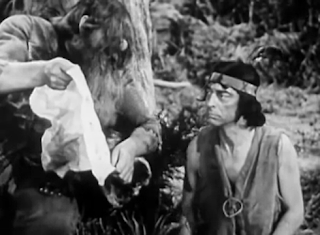Here’s
the last of Buster’s late-career features that I have access to, and it’s not a
particularly good one. Granted, I’ve
never read the comic strip that it’s based on (and really, any feature film
based on a comic strip is probably stretching it – there’s a reason Peanuts mostly stuck to half-hour TV
specials,) but there’s still not much here.
Also, it’s a film where it’s difficult to enjoy Buster’s part.
In the
hillbilly town of Dogpatch, strapping young simpleton Li’l Abner spends his
days getting easily confused and trying to avoid matrimonial
entanglements. One day, he has the
misfortune to have two women both declaring him their betrothed, and with Sadie
Hawkins Day coming up – in which all the unmarried women chase all the
bachelors through town, and any woman who catches a man is entitled to marry
him – he doesn’t like his odds.
Again, I
don’t know much of anything about the comic strip, although I’m guessing the
movie’s visuals are pretty accurate: the
giant fake noses on Li’l Abner’s parents and the overall look of comic sidekick
Hairless Joe are very cartoony, so I’m assuming the film basically brings the
comic strip to life. For a
seventy-five-minute string of hillbilly jokes, stupid jokes, and marriage
jokes, it’s cute enough but incredibly lightweight. It did occur to me that Li’l Abner’s
characterization of running away from women is similar to Jughead’s longtime
M.O. in Archie comics, and I amused
myself by imagining Li’l Abner as ace (although he seems to like Daisy Mae
fairly well – it’s more just that he doesn’t want to be a husband.)
Like Pajama Party, this is another unpleasant
case of Buster playing a Native American, in this case the supporting character
Lonesome Polecat. I wouldn’t say the
film leans into the stereotypes quite as hard as the Pajama Party does, but it’s still uncomfortable to see. That said, he isn’t in it much. Mainly, he’s in a short comic bit at the
beginning of the film and is featured more in the Sadie Hawkins Day sequence,
where both he and Hairless Joe are thwarted in their attempts to get snagged by
a woman (as opposed to all the other guys, who are trying to run away from them.)
If
there’s an upside, it’s that it has me thinking more about race in Buster’s
silent work. I’ve discussed before that
there’s certainly some unpleasant humor to be found there – I don’t want to
excuse any of the insensitive jokes in his films – and he took his own turn at
“Indian humor” in The Paleface. That said, I’d say both Li’l Abner in 1940 and Pajama
Party in 1964 are more racist than anything Buster made in the 1920s. And since I can’t imagine Hollywood in the
‘20s was less racist than it was in
the ‘40s or ‘60s, then it’s likely that Buster’s classic works aren’t nearly as
racist as they could have been, and I’d guess we have Buster to thank for
that. That’s a very weird sort of faint
praise, but given the times, I do think it’s something worth crediting.
On
another note, this is going to be my last Buster Monday post. Not that I’m done writing about him! I’m going to keep up the 100 Years of Buster
Keaton write-ups, and I’ll post anything else that strikes me, but after about
three years and over 150 posts, I’m just running out of stuff to write about him
every single week. It’s been super fun,
and again, Buster Keaton posts will keep coming, just not quite as frequently.
Warnings
Drinking/smoking,
a little slapstick violence, and unfortunate racial stereotypes.

No comments:
Post a Comment